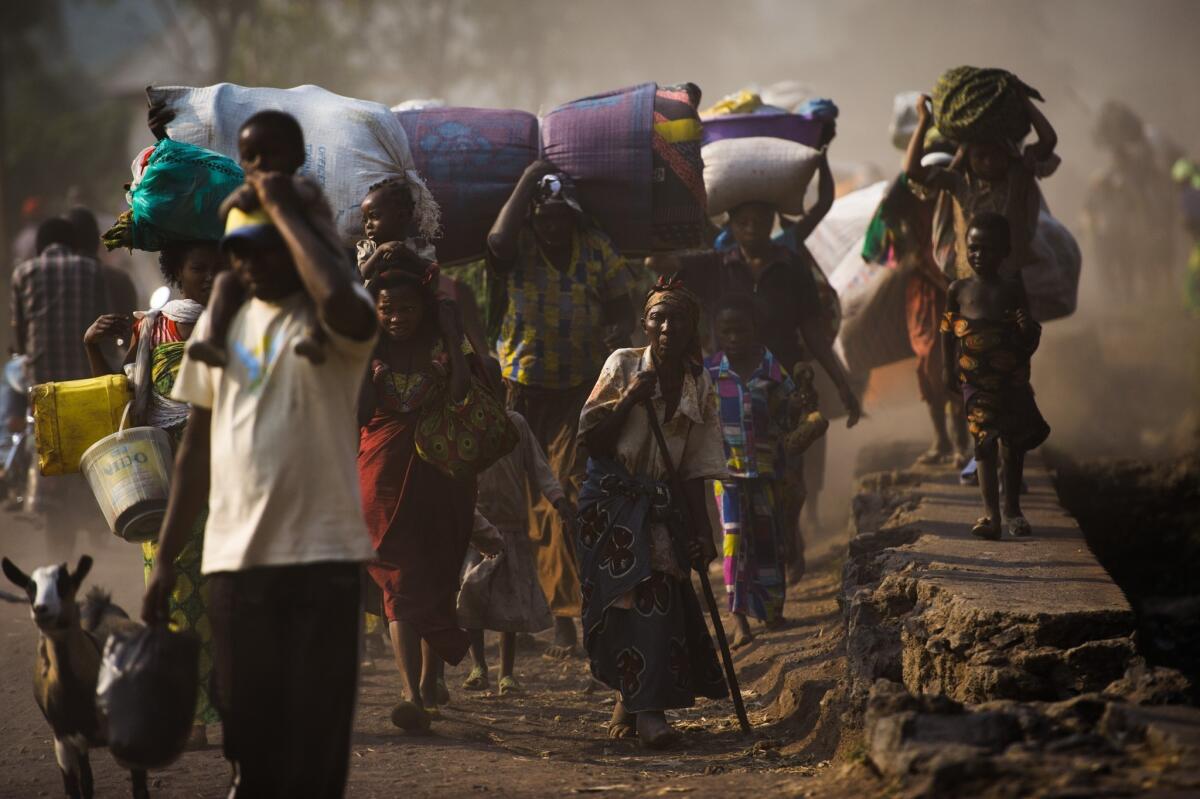Return to violence in eastern Congo; soldiers disguised as women

- Share via
JOHANNESBURG, South Africa -- In the far east of the Democratic Republic of Congo, residents were greeted with an odd sight over the weekend: trucks full of people dressed in brightly colored women’s clothes, coming from Rwanda.
They weren’t women. They were armed men in military uniforms with scarves called kikwembe draped over their heads and clothing.
A farmer who saw them felt dread when he realized who they were, the Associated Press reported. They were soldiers, apparently arriving from Rwanda to fight on the side of the M23 rebels.
It could mean only one thing: a slide back into war. He told his wife to flee to Goma, the regional capital.
New fighting broke out Sunday in the east after peace talks in neighboring Uganda between the Congolese government and the rebels recently stalled.
“They were wearing kikwembe to confuse us, to conceal the fact they were soldiers,” farmer Bifumbu Ruhira, from Kanyarucinya village, told the news service. “The whole village was afraid and I said to my wife, ‘Get to Goma.’”
Resource-rich eastern Congo is one of the world’s most troubled regions. The on-and-off conflict, much of it fueled by a struggle for control of mines and mineral assets, has dragged on since the late 1990s.
M23, a new guerrilla group, emerged last year, repudiating a 2009 peace deal that had seen rebel fighters folded into the army.
The United Nations peacekeeping mission in eastern Congo, known by its initials MONUSCO, said Sunday’s fighting began when M23 rebels attacked the Congolese army in Mutaho, just northwest of Goma. The acting U.N. special representative in the country, Moustapha Soumare, warned that any attempt by rebels to advance on Goma would be regarded as a direct threat to civilians.
He called on all sides to abide by the peace deal.
Jason Stearns, a Congo analyst, noted Monday in a blog post that the new fighting followed a pattern of attacks and counterattack between government and rebel forces over the years.
“In past weeks, a variety of militia loosely allied to the Congolese government have launched attacks against the M23. And now it is the M23’s turn again to strike” against the army, he wrote.
Part of the problem, he wrote, was that neither side appears to take seriously the peace talks in Kampala, the Ugandan capital.
“Both parties deploy large delegations to the Ugandan capital, where they spend weeks at a time without meeting each other. The Congolese prevaricate between a refusal to negotiate, an ultimatum for the M23 to sign a proposed deal (several of these have come and gone), and a more flexible stance,” he wrote.
In November, M23 rebels captured Goma, a shock for Congo’s central government. They pulled out less than two weeks later, paving the way for the latest peace talks, which began the following month.
A broad peace deal involving both sides and regional powers was signed in February. Government and rebel representatives continued negotiations on the details in Kampala.
The latest offer from the government, made last week, required M23 to disband in return for amnesty and integration of rebel soldiers into the army, a formula that has been tried in the past with little success. Government jobs also would be found for the movement’s political leaders.
U.N. experts have reported that the rebellion is fueled by Rwanda, which sees its security threatened by the chaos in the east, with its soldiers participating in and even leading the M23 attacks. Rwanda has denied the accusation.
On Monday, the Congolese army claimed to have the upper hand in the fighting, announcing it had killed more than 100 rebels. The claims could not be verified. Some analysts suggest the army seems confident of defeating M23 on the battlefield, averting the need for concessions.
The fighting comes as a new U.N. intervention force is about to be deployed, authorized by the Security Council in March with a mandate not just to carry out peacekeeping operations, but also to intervene and stamp out rebel groups in eastern Congo.
In the past, the 19,800-strong MONUSCO, the U.N.’s largest peacekeeping force, has been criticized for failing to protect civilians from attacks and atrocities by the myriad militias across the region.
“It is unlikely the [new] U.N. brigade will have the capacity or will to flush these forces out,” wrote analysts Thierry Vircoulon and Piers Pigou, both of the International Crisis Group, in a South African newspaper last week.
They argued that one of the problems was the Congolese government’s lack of commitment to reform in the east.
“A combination of limited capacity and inadequate political will has consistently stymied reforms, fundamentally undermining longer-term prospects for political and security stability,” they argued.
ALSO:
China economic growth slows, partly on purpose
Israel in middle of legal tussle between U.S. and China
Bangladesh sentences former Islamist party leader for war crimes
.
More to Read
Sign up for Essential California
The most important California stories and recommendations in your inbox every morning.
You may occasionally receive promotional content from the Los Angeles Times.










